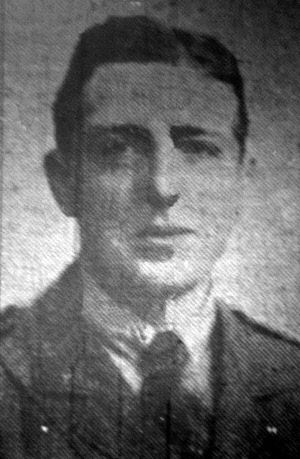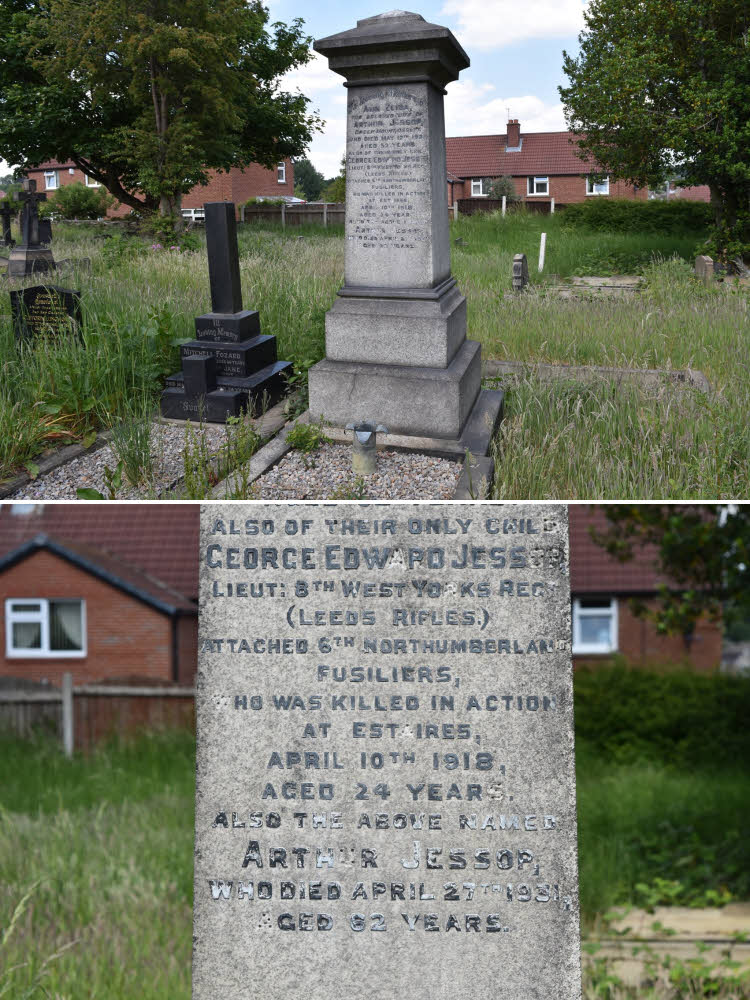
George Edward Jessop was born in 1893, the only child of Ossett mill owner Arthur Jessop and his wife Ann Eliza (nee Clay) who had married in 1891. The Jessop family lived at the imposing “Green Lea”, Healey Road, Ossett in 1911 and Arthur Jessop had his mungo, shoddy and wool extraction business just down road in one of the big Healey mills. At the time, several Ossett men who signed up in Kitchener’s army worked for the Jessops and young George Jessop, then aged 17 years was no exception.
George Jessop was married on the 15th March 1918 at the Wesleyan Chapel, Wesley Street, Ossett to Gladys Mary Mitchell, the daughter of George William Mitchell. Less than four weeks later, George Jessop lost his life at the age of 24 years on the 10th April 1918 during the big German Spring offensive. His widow Gladys remarried in 1920 to a man called William Colbeck and lived at 56, Shaftesbury Avenue, Roundhay, Leeds.
George Jessop earned his commission on the 8th July 1915 and he embarked for France on the 21st August 1916, joining the 8th Battalion of the West Yorkshire Regiment, which was a Territorial force also known as the “Leeds Rifles”. He was at some stage attached to the 6th Battalion of the Northumberland Fusiliers and was serving with them at the time of his death. Lieutenant Jessop was awarded the Victory and British Medals posthumously.
April 1918 is the first time the 6th Battalion of the Northumberland Fusiliers did not submit a War Diary. A note from the Commanding Officer says:
“Owing to the exceptional volume of heavy casualties suffered by this Battalion lately, which include the C.O. Adjutant and Intelligence officer, great difficulty is being experienced in obtaining authentic data for the continuous history of the operations in which this unit has taken part during the period covered by the War Diary in question. Major Leathart at present at Le Touquet, is the only surviving officer who can supply the necessary facts and he will not be returning to the Battalion until the end of the present week, I fear it will not be possible to submit the War Diary for April at the stipulated time. It will be forwarded at the earliest possible moment.”
In the “50th Division History” – Everard Wyrall notes that:
“The earliest possible moment never came, for the 6th Northumberland Fusiliers moved down to the Aisne and there shared the tragic fate of other units of the 50th Division.”
The 6th Battalion, Northumberland Fusiliers had been heavily involved with the 50th Div 149th Brigade close to Estaires in the fighting to protect the crossings of the Lys. On the 10th April 1918, at 3. 15 p.m. the 5th & 6th Northumberland Fusiliers moved into position in support of the 150th Brigade with instructions that the line of the River Lys and River Lawe to be held at all costs and this is probably where Lieutenant Jessop lost his life.

Above: Map of the Battle of Estaires, 9th – 11th April 1918.
Early in the morning of the 10th April, the Germans launched heavy attacks covered by artillery fire about the river crossings at Lestrem and Estaires, and succeeded in reaching the left bank at both places; but in each case he was driven back again by determined counter-attacks by the 50th (Northumbrian) Division. The enemy continued to exercise great pressure at Estaires, and fierce street fighting took place, in which both sides lost heavily. Machine guns, mounted by our troops in the upper rooms of houses, did great execution on has troops as they moved up to the attack, until the machine guns were knocked out by artillery fire. In the evening the German infantry once more forced their way into Estaires, and after a most gallant resistance the 50th Division withdrew at nightfall to a prepared position to the north and west of the town. East of Estaires the enemy had already crossed the Lys in strength, with artillery in close support of his infantry, and by the evening had pressed back our troops to a position north of Steenwerck. Thereafter, the arrival of British reinforcements for the time being held up his advance.
His probate record shows:
“George Edward Jessop of Green Mount, Ossett, Lieutenant in the Northumberland Fusiliers died 10th April 1918 in France. Administration at Wakefield 11th December 1918 to Gladys Mary Jessop, widow. Effects £432 4s 4d.”
In 1920, Jessop’s widow Gladys went on to remarry to William Henry Colbeck and the couple lived subsequently at 56, Shaftesbury Avenue, Roundhay, Leeds.
The “Ossett Observer” 1 had this obituary for Lieutenant George Jessop:
“The sad news came last week that Lieut. George Edward Jessop, of Ossett, had been killed in action in France. The young officer, who was 24 years of age, was the only son of Mr. and Mrs. Arthur Jessop, of Green Mount, Ossett, and was well-known and popular. He was in the West Yorkshire Regiment, attached to the Northumberland Fusiliers, and had been in the military forces nearly three years. A well-built, upstanding young man, he offered himself for enlistment in a line regiment in December 1914, and was rejected, but after attending the Officer’s Training Corps at Leeds, obtained his commission in June 1915. He had been in France nearly two years, and had seen a great deal of fighting, mainly on the Arras and Somme fronts. When last over on leave, he was married, on March 12th, to Miss Gladys Mary Mitchell, daughter of the late Mr. G.W. Mitchell, and could not have been back at the front for more than a fortnight when his death took place. Before obtaining his commission, the deceased officer was associated with his father in the business of Jessop Bros., mungo manufacturers.”
Lieutenant George E. Jessop is remembered on Panels 3 and 4 of the Ploegsteert Memorial 2, Hainaut, Belgium. The Ploegsteert Memorial stands in Berks Cemetery Extension, which is located 12.5 Kms south of Ieper town centre, on the N365 leading from Ieper to Mesen (Messines), Ploegsteert and on to Armentieres.
The Ploegsteert Memorial commemorates more than 11,000 servicemen of the United Kingdom and South African forces who died in this sector during the First World War and have no known grave. The memorial serves the area from the line Caestre-Dranoutre-Warneton to the north, to Haverskerque-Estaires-Fournes to the south, including the towns of Hazebrouck, Merville, Bailleul and Armentieres, the Forest of Nieppe, and Ploegsteert Wood. The original intention had been to erect the memorial in Lille.

Above: The Jessop grave at St. John’s Methodist Chapel showing the memorial to George Edward Jessop, the only child of Arthur Jessop. Picture courtesy of Lisa Jennings.
References:
1. “Ossett Observer”, 28th April 1918